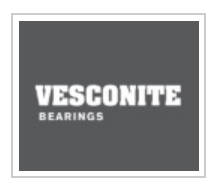Welcome to Sino Bearings web
24x7 HOTLINE:+86-28-81454188

 NEWS
NEWS
Vesconite Bearings is exploring new engineering design methods, including reducing or eliminating grooves, where possible, in industrial and marine applications.
Vesconite’s bearing materials are internally lubricated so, when replacing traditional materials, Vesconite is challenging engineers to explore designs that remove redundant or superfluous grooves for cooling lubricant or water.
For instance, Vesconite engineers have redesigned a forklift lower wear pad without the seven grooves on the upper surface that were in place in the original moulded nylon parts.
“Eliminating grooves improves the structural integrity of the part and reduces manufacturing times and costs,” says forklift application engineer Calvin Mpofu.
Similarly, Vesconite Bearings can better on previous marine stern-tube bearing designs where constant water cooling is needed and bushings have water circulation grooves.
“The number of grooves can be reduced where the groove radius and depth can be altered to obtain a sufficient flow of water for cooling,” reinforces marine application engineer Wian Venter.
As a result, Vesconite Bearings has suggested a reduction in the number of stern-tube grooves in a case where the original design was a rubber Cutlass bearing.
This original design, which included a nitrile rubber lining bonded to a brass shell, required many grooves running the length of the rubber lining to dissipate frictional heat and increase the cooling flow of water.